七年级下册英语语法重点归纳整理资料讲解
- 格式:doc
- 大小:59.01 KB
- 文档页数:9
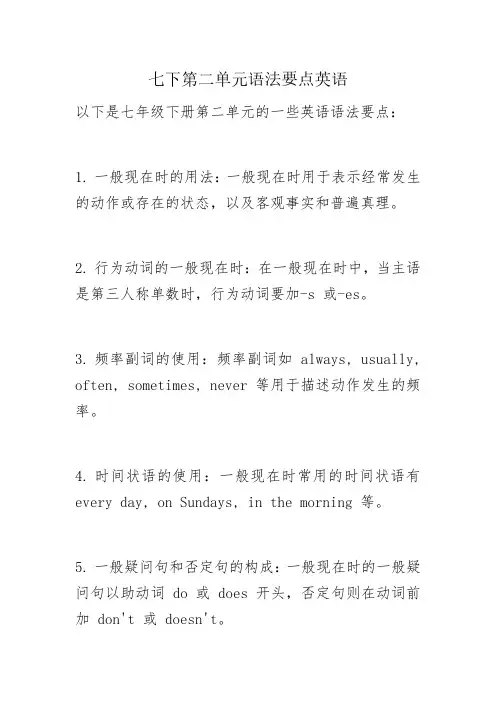
七下第二单元语法要点英语
以下是七年级下册第二单元的一些英语语法要点:
1.一般现在时的用法:一般现在时用于表示经常发生的动作或存在的状态,以及客观事实和普遍真理。
2.行为动词的一般现在时:在一般现在时中,当主语是第三人称单数时,行为动词要加-s或-es。
3.频率副词的使用:频率副词如always,usually, often,sometimes,never等用于描述动作发生的频率。
4.时间状语的使用:一般现在时常用的时间状语有every day,on Sundays,in the morning等。
5.一般疑问句和否定句的构成:一般现在时的一般疑问句以助动词do或does开头,否定句则在动词前加don't或doesn't。
6.介词的用法:介词用于表示时间、地点、方位等。
7.名词所有格的构成:名词所有格用于表示所属关系,通常在名词后加's。
8.形容词性物主代词的用法:形容词性物主代词用于修饰名词,起到限定作用。
这些是七年级下册第二单元的一些语法要点,希望对你有所帮助!。
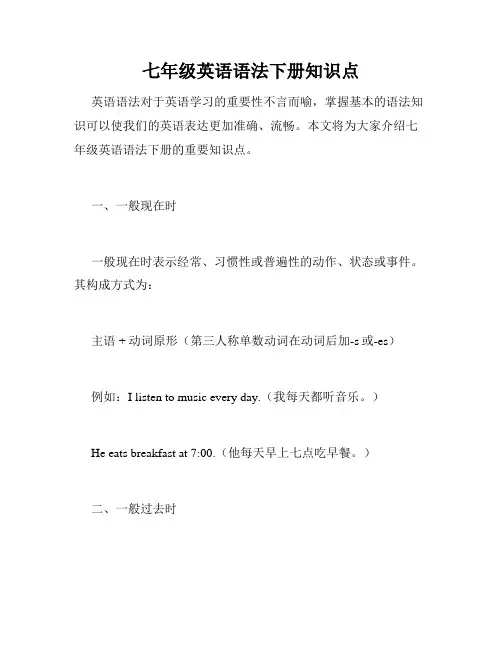
七年级英语语法下册知识点英语语法对于英语学习的重要性不言而喻,掌握基本的语法知识可以使我们的英语表达更加准确、流畅。
本文将为大家介绍七年级英语语法下册的重要知识点。
一、一般现在时一般现在时表示经常、习惯性或普遍性的动作、状态或事件。
其构成方式为:主语 + 动词原形(第三人称单数动词在动词后加-s或-es)例如:I listen to music every day.(我每天都听音乐。
)He eats breakfast at 7:00.(他每天早上七点吃早餐。
)二、一般过去时一般过去时表示在过去发生的动作或存在的状态。
其构成方式可以分为以下两种情况:1. 对于规则动词,其构成方式为:主语 + 动词过去式例如:I played soccer yesterday.(我昨天踢了足球。
)2. 对于不规则动词,其过去式需要进行记忆,例如:be → was/were;have/has → had;do/does → did;go → went例如:She went to the park last weekend.(她上周末去了公园。
)三、现在进行时现在进行时表示现在正在进行的动作,其构成方式为:主语 + am/is/are + 现在分词例如:They are studying English now.(他们正在学习英语。
)四、比较级和最高级比较级表示两个人或事物在某方面的比较,最高级则表示三者或三个以上在某方面的比较。
其构成方式为:比较级:形容词或副词 + -er(某些则需在最后加-y变为-i再加-er);最高级:形容词或副词 + -est(某些则需在最后加-y变为-i再加-est)例如:He is taller than his brother.(他比他弟弟高。
)She is the tallest girl in her class.(她是班里最高的女孩。
)五、一般将来时一般将来时表示将来要发生的动作或存在的状态。
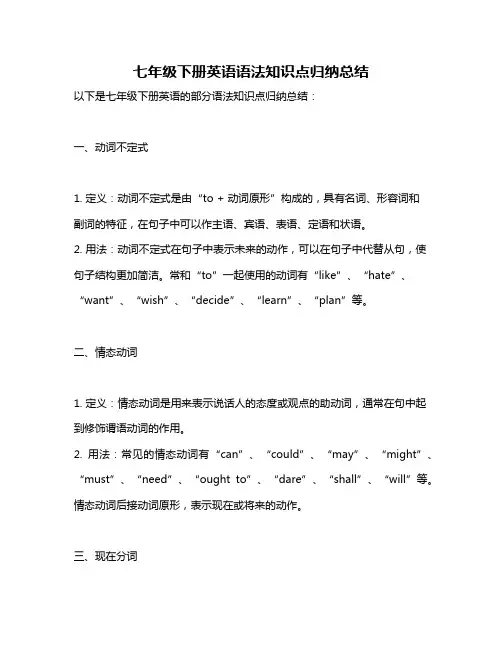
七年级下册英语语法知识点归纳总结以下是七年级下册英语的部分语法知识点归纳总结:一、动词不定式1. 定义:动词不定式是由“to + 动词原形”构成的,具有名词、形容词和副词的特征,在句子中可以作主语、宾语、表语、定语和状语。
2. 用法:动词不定式在句子中表示未来的动作,可以在句子中代替从句,使句子结构更加简洁。
常和“to”一起使用的动词有“like”、“hate”、“want”、“wish”、“decide”、“learn”、“plan”等。
二、情态动词1. 定义:情态动词是用来表示说话人的态度或观点的助动词,通常在句中起到修饰谓语动词的作用。
2. 用法:常见的情态动词有“can”、“could”、“may”、“might”、“must”、“need”、“ought to”、“dare”、“shall”、“will”等。
情态动词后接动词原形,表示现在或将来的动作。
三、现在分词1. 定义:现在分词是动词的一种形式,具有形容词的特征,可以表示正在进行的动作或状态。
2. 用法:现在分词可以作定语、表语和状语。
常和“-ing”一起使用的动词有“seeing”、“feeling”、“thinking”、“doing”、“being”等。
四、介词短语1. 定义:介词短语是由介词和名词或代词构成的短语,用来表示时间、地点、方式等。
2. 用法:介词短语在句子中可以作状语、定语和表语。
常见的介词有“in”、“on”、“at”、“for”、“with”、“by”等。
五、连词1. 定义:连词是用来连接两个句子或从句的词语,表示它们之间的关系。
2. 用法:常见的连词有“and”、“but”、“or”、“so”、“because”、“if”等。
连词在句子中起到承上启下的作用,使句子的意思更加清晰。
以上是七年级下册英语的部分语法知识点归纳总结,希望对你有所帮助。
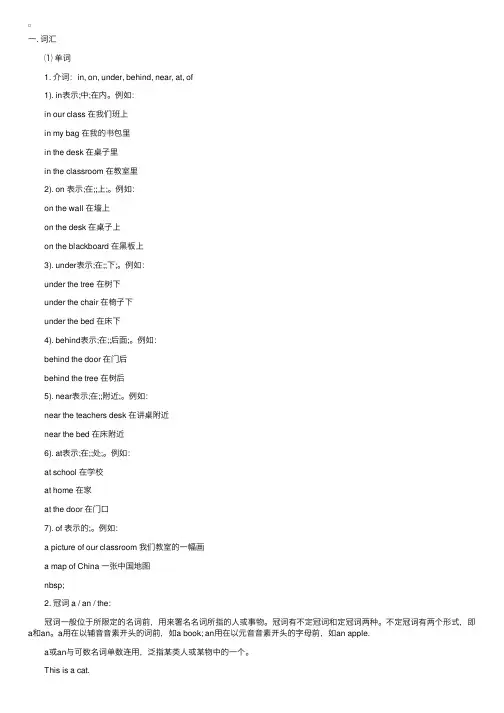
⼀. 词汇 ⑴单词 1. 介词:in, on, under, behind, near, at, of 1). in表⽰;中;在内。
例如: in our class 在我们班上 in my bag 在我的书包⾥ in the desk 在桌⼦⾥ in the classroom 在教室⾥ 2). on 表⽰;在;;上;。
例如: on the wall 在墙上 on the desk 在桌⼦上 on the blackboard 在⿊板上 3). under表⽰;在;;下;。
例如: under the tree 在树下 under the chair 在椅⼦下 under the bed 在床下 4). behind表⽰;在;;后⾯;。
例如: behind the door 在门后 behind the tree 在树后 5). near表⽰;在;;附近;。
例如: near the teachers desk 在讲桌附近 near the bed 在床附近 6). at表⽰;在;;处;。
例如: at school 在学校 at home 在家 at the door 在门⼝ 7). of 表⽰的;。
例如: a picture of our classroom 我们教室的⼀幅画 a map of China ⼀张中国地图 nbsp; 2. 冠词 a / an / the: 冠词⼀般位于所限定的名词前,⽤来署名名词所指的⼈或事物。
冠词有不定冠词和定冠词两种。
不定冠词有两个形式,即a和an。
a⽤在以辅⾳⾳素开头的词前,如a book; an⽤在以元⾳⾳素开头的字母前,如an apple. a或an与可数名词单数连⽤,泛指某类⼈或某物中的⼀个。
This is a cat. 这是⼀只猫。
It#39;s an English book. 这是⼀本英语书。
His father is a worker. 他的爸爸是个⼯⼈。
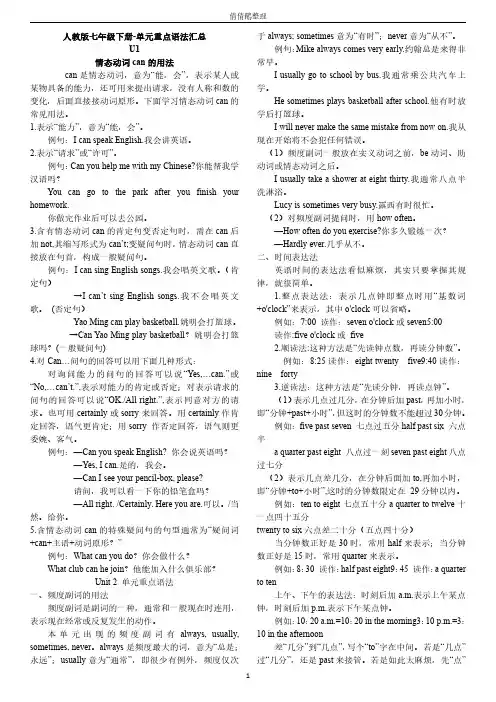
人教版七年级下册-单元重点语法汇总U1情态动词can的用法can是情态动词,意为“能,会”,表示某人或某物具备的能力,还可用来提出请求,没有人称和数的变化,后面直接接动词原形。
下面学习情态动词can的常见用法。
1.表示“能力”,意为“能,会”。
例句:I can speak English.我会讲英语。
2.表示“请求”或“许可”。
例句:Can you help me with my Chinese?你能帮我学汉语吗?You can go to the park after you finish your homework.你做完作业后可以去公园。
3.含有情态动词can的肯定句变否定句时,需在can后加not,其缩写形式为can’t;变疑问句时,情态动词can直接放在句首,构成一般疑问句。
例句:I can sing English songs.我会唱英文歌。
(肯定句)→I can’t sing English songs.我不会唱英文歌。
(否定句)Yao Ming can play basketball.姚明会打篮球。
→Can Yao Ming play basketball?姚明会打篮球吗?(一般疑问句)4.对Can…问句的回答可以用下面几种形式:对询问能力的问句的回答可以说“Yes,…can.”或“No,…can’t.”,表示对能力的肯定或否定;对表示请求的问句的回答可以说“OK./All right.”,表示同意对方的请求。
也可用certainly或sorry来回答。
用certainly作肯定回答,语气更肯定;用sorry作否定回答,语气则更委婉、客气。
例句:—Can you speak English?你会说英语吗?—Yes,I can.是的,我会。
—Can I see your pencil-box,please?请问,我可以看一下你的铅笔盒吗?—All right./Certainly.Here you are.可以。
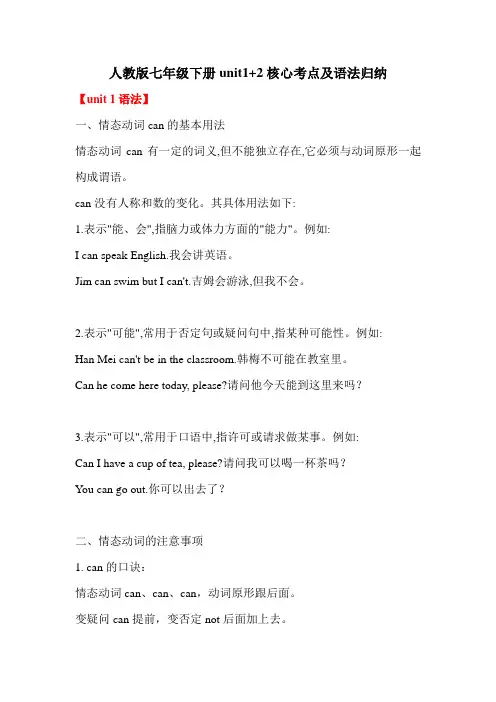
人教版七年级下册unit1+2核心考点及语法归纳【unit 1语法】一、情态动词can的基本用法情态动词can有一定的词义,但不能独立存在,它必须与动词原形一起构成谓语。
can没有人称和数的变化。
其具体用法如下:1.表示"能、会",指脑力或体力方面的"能力"。
例如:I can speak English.我会讲英语。
Jim can swim but I can't.吉姆会游泳,但我不会。
2.表示"可能",常用于否定句或疑问句中,指某种可能性。
例如:Han Mei can't be in the classroom.韩梅不可能在教室里。
Can he come here today, please?请问他今天能到这里来吗?3.表示"可以",常用于口语中,指许可或请求做某事。
例如:Can I have a cup of tea, please?请问我可以喝一杯茶吗?You can go out.你可以出去了?二、情态动词的注意事项1. can的口诀:情态动词can、can、can,动词原形跟后面。
变疑问can提前,变否定not后面加上去。
主语人称单复数,情态动词不能变。
2. 情态动词can可以引导肯定句和疑问句。
肯定句:主语+ can + 动词原形+ 其他成分疑问句:can + 主语+ 动词原形+ 其他成分3.can 引导的肯定句变为疑问句的方法:(一调二改三问号)can 提前,首字母大写。
(一调)肯定句中主语在变成疑问句时的变化。
(二改)如:肯定句:You can feed the animals.你可以喂动物。
疑问句:Can I feed the animals?我能喂动物吗?在句尾后面加问号。
(三问号)4. Can的一般疑问句回答:肯定回答:Yes,主语(必须人称代词)+ can.否定回答:No,主语(必须人称代词)+ can not (can’t)/mustn’t. Yes 或no 后要使用逗号,除了I 以外,其他人称都要小写。
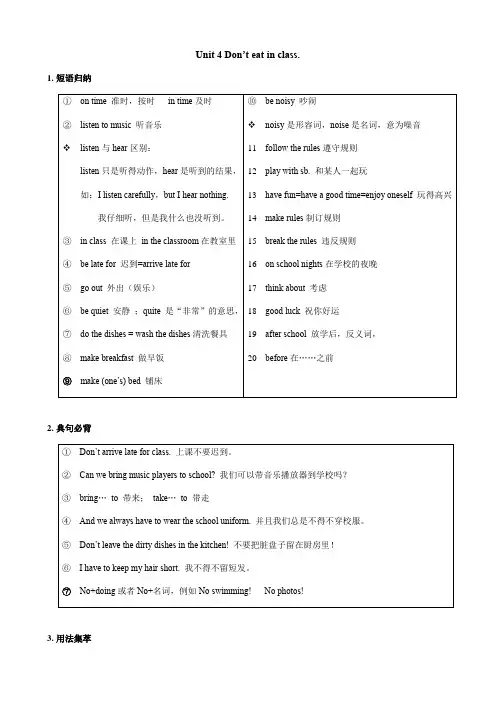
Unit 4 Don’t eat in class.1.短语归纳2.典句必背3.用法集萃(1)Don’t arrive late for class. 不要上课迟到❖arrive in❖arrive at(2)You must be on time. 你必须准时。
❖on time是固定搭配,意为“按时;准时”。
例:Don’t worry. The train will arrive on time. 别担心。
火车会准时到达的。
❖常见的time短语(3)Don’t listen to music in class. 不要上课时听音乐牛刀小试—Do you like the songs by Taylor?一Yes. Country music ______ nice and full of feelings.A. SoundsB.listensC. hearsD. looks(4)This is very important. 这是很重要的❖important作形容词,意为“重要的”。
如:The first lesson is very important. 第一课是很重要的❖反义词:unimportant adj. 不重要的❖派生词:importance n. 重要;重要性(5)Can we bring music players to school? 我们可以把音乐播放器带到学校里来吗?❖bring作动词,意为“带来;拿来”例:Don’t forget to bring your homework here. 不要忘记把你的家庭作业带过来❖辨析bring, take, carry和get牛刀小试Don’t forget _____ your photos here when you come to school.A.bringingB. to takeC. takingD. to bring(6)Oh, and we also have to be quiet in the library. 哦,我们在图书馆里还必须保持安静❖quiet作形容词,意为“安静的”,可以用来修饰人,也可以用来形容地点或场所等。
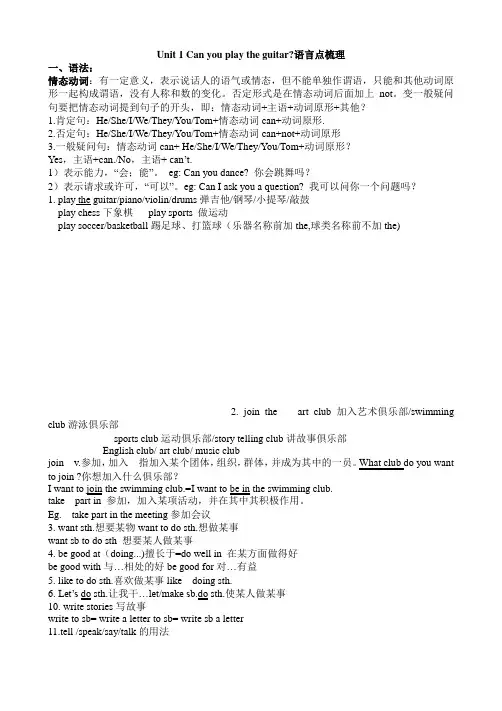
Unit 1 Can you play the guitar?语言点梳理一、语法:情态动词:有一定意义,表示说话人的语气或情态,但不能单独作谓语,只能和其他动词原形一起构成谓语,没有人称和数的变化。
否定形式是在情态动词后面加上not。
变一般疑问句要把情态动词提到句子的开头,即:情态动词+主语+动词原形+其他?1.肯定句:He/She/I/We/They/You/Tom+情态动词can+动词原形.2.否定句:He/She/I/We/They/You/Tom+情态动词can+not+动词原形3.一般疑问句:情态动词can+ He/She/I/We/They/You/Tom+动词原形?Yes,主语+can./No,主语+ can’t.1)表示能力,“会;能”。
eg: Can you dance? 你会跳舞吗?2)表示请求或许可,“可以”。
eg: Can I ask you a question? 我可以问你一个问题吗?1. play the guitar/piano/violin/drums弹吉他/钢琴/小提琴/敲鼓play chess下象棋play sports 做运动play soccer/basketball踢足球、打篮球(乐器名称前加the,球类名称前不加the)2. join the art club加入艺术俱乐部/swimming club游泳俱乐部sports club运动俱乐部/story telling club讲故事俱乐部English club/ art club/ music clubjoin v.参加,加入指加入某个团体,组织,群体,并成为其中的一员。
What club do you want to join ?你想加入什么俱乐部?I want to join the swimming club.=I want to be in the swimming club.takeEg. take part in the meeting参加会议3. want sth.想要某物want to do sth.想做某事want sb to do sth 想要某人做某事4. be good at(doing...)擅长于=do well in 在某方面做得好be good with与…相处的好be good for对…有益5. like to do sth.喜欢做某事like doing sth.6. Let’s do sth.让我干…let/make sb.do sth.使某人做某事10. write stories写故事write to sb= write a letter to sb= write sb a letter11.tell /speak/say/talk的用法1) tell讲述一件事实或故事等及物动词tell sb. sth 给某人讲某事=tell sth to sb 把某事告诉某人tell sb. to do sth 告诉某人做某事tell stories讲故事=tell a story tell a lie撒谎2)speak v. 主要是讲说话的能力,往往接语言speak English讲英语3)talk 为不及物动词往往加介词再接宾语talk to sb.和…交谈/talk with sb.和…交谈(指双方)4)say往往接说话的内容eg.Our teacher says we should study hard.say it in English用英语说它12. make friends with sb.和…交朋友13. play games with sb.和…做游戏14. help sb. with sth.= help sb. (to) do sth.帮助某人做某事15. call sb. at +电话号码给某人打电话拨+号码16. on /at the weekend 在周末on weekends after school放学后17.do Chinese kung fu 打中国功夫18.be free 空闲的19. sing very well 唱得好That sounds good. 那听起来很好20.English-speaking students 讲英语的学生学生运动中心23.also /too/eitheralso/too用在肯定句,also 用于句中,too 用于句尾,either用于否定句句未eg. I am a student . He is a student,too. I am a student . He is also a student.I am not a student . He is not a student, either.24.and/or 连接两个并列成分eg.I can sing and dance.(and用于肯定句)I can’t sing or dance.(or用于否定句)Can you sing or dance ?(or用于选择疑问句“或者”)25.at27. need to do sth需要干某事need sb. to do sth 需要某人干某事28.wanted students for School show学校表演招聘学生v.展示;给….看… show sb. Sth= show Sth to sb.给某人展示n.节目;表演TV show电视节目29.teach v.教,讲授teacher n.教师teach sb.English教某人英语teach sb. sth .= teach sth to sb.教给某人某事=教某事给某人teach sb.to do sth教给某人做某事30.music n.音乐musician n. 音乐家31.piano (pl.) pianosUnit 2 What time do you go to school?知识点梳理1.What time do you get up?What time +助动词do/does +主语+动词原形,询问某人做某事的具体时间。

七年级下册英语语法复习总结一、冠词的用法定冠词the的用法1、特指某(些)人或某(些)事物。
e.g.: The man in a white car is Tom's father.2、指上下文已经提到的人或事物。
e.g.: Nancy bought a storybook. The book is very interesting.3、用在世界上独一无二的名词前。
e.g.: The sun is bigger than the moon.4、用在乐器名词前。
e.g.: She often plays the piano after school.5、用在方位名词前。
e.g.: in the east\the west\the north\the south; on the left\the right6、用在叙述词和形容词最高级前。
e.g.: Xiao Ming is the tallest boy in his class.7、用在某些形容词前,表示一类人。
e.g.: the old; the poor; the sick; the blind8、用在江河、海洋、山川、湖泊、群岛的名称前。
e.g.: the Great Wall; the West Lake9、用在由普通名词和另外一些词构成的国家名称、机构团体等专有名词前。
e.g.: the United Nations; the United States10、用在某些习惯用语中。
e.g.: in the sky; at the same time; all the time; at the weekend; by the way不定冠词a\an的用法。
1、表示类别,反之一类人或物。
e.g.: A horse is bigger than a rabbit.2、指某人或某物,但不具体指明是哪个人或物。
e.g.: A woman is waiting for you at the gate.3、表示数量“一”,但数的概念不如one强烈。
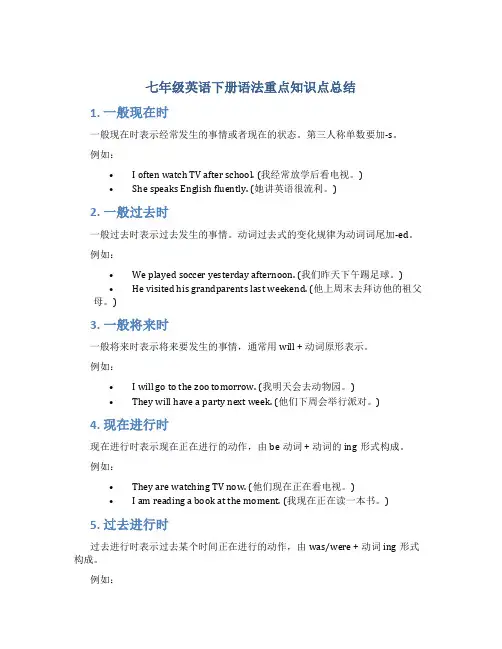
七年级英语下册语法重点知识点总结1. 一般现在时一般现在时表示经常发生的事情或者现在的状态。
第三人称单数要加-s。
例如:•I often watch TV after school. (我经常放学后看电视。
)•She speaks English fluently. (她讲英语很流利。
)2. 一般过去时一般过去时表示过去发生的事情。
动词过去式的变化规律为动词词尾加-ed。
例如:•We played soccer yesterday afternoon. (我们昨天下午踢足球。
)•He visited his grandparents last weekend. (他上周末去拜访他的祖父母。
)3. 一般将来时一般将来时表示将来要发生的事情,通常用will + 动词原形表示。
例如:•I will go to the zoo tomorrow. (我明天会去动物园。
)•They will have a party next week. (他们下周会举行派对。
)4. 现在进行时现在进行时表示现在正在进行的动作,由be动词 + 动词的ing形式构成。
例如:•They are watching TV now. (他们现在正在看电视。
)•I am reading a book at the moment. (我现在正在读一本书。
)5. 过去进行时过去进行时表示过去某个时间正在进行的动作,由was/were + 动词ing形式构成。
例如:•I was watching TV at 8pm yesterday. (昨天晚上8点我正在看电视。
)•They were studying English when I called them. (我给他们打电话时,他们正在学习英语。
)6. 现在完成时现在完成时表示过去的动作对现在仍有影响,由have/has + 过去分词构成。
例如:•I have finished my homework. (我已经完成了我的作业。
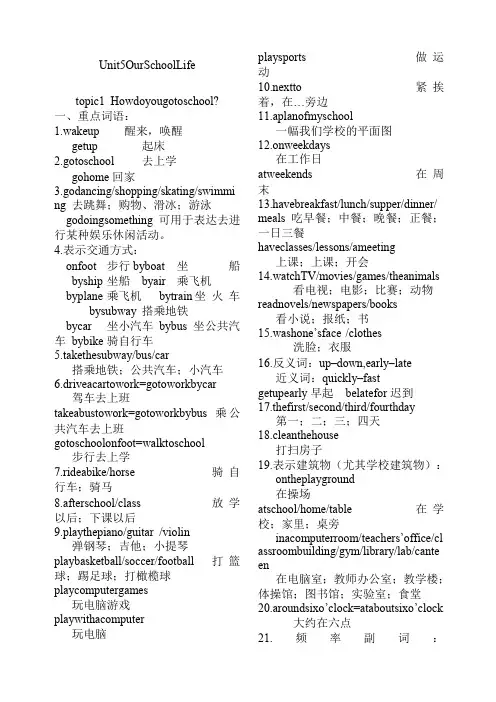
Unit5OurSchoolLifetopic1 Howdoyougotoschool?一、重点词语:1.wakeup 醒来,唤醒getup 起床2.gotoschool 去上学gohome回家3.godancing/shopping/skating/swimmi ng 去跳舞;购物、滑冰;游泳godoingsomething可用于表达去进行某种娱乐休闲活动。
4.表示交通方式:onfoot 步行byboat 坐船byship 坐船byair 乘飞机byplane 乘飞机bytrain 坐火车bysubway 搭乘地铁bycar 坐小汽车bybus坐公共汽车bybike 骑自行车5.takethesubway/bus/car搭乘地铁;公共汽车;小汽车6.driveacartowork=gotoworkbycar驾车去上班takeabustowork=gotoworkbybus乘公共汽车去上班gotoschoolonfoot=walktoschool步行去上学7.rideabike/horse 骑自行车;骑马8.afterschool/class 放学以后;下课以后9.playthepiano/guitar /violin弹钢琴;吉他;小提琴playbasketball/soccer/football 打篮球;踢足球;打橄榄球playcomputergames玩电脑游戏playwithacomputer玩电脑playsports 做运动10.nextto 紧挨着,在…旁边11.aplanofmyschool一幅我们学校的平面图12.onweekdays在工作日atweekends 在周末13.havebreakfast/lunch/supper/dinner/ meals吃早餐;中餐;晚餐;正餐;一日三餐haveclasses/lessons/ameeting上课;上课;开会14.watchTV/movies/games/theanimals看电视;电影;比赛;动物readnovels/newspapers/books看小说;报纸;书15.washone’sface /clothes洗脸;衣服16.反义词:up–down,early–late近义词:quickly–fastgetupearly早起belatefor迟到17.thefirst/second/third/fourthday第一;二;三;四天18.cleanthehouse打扫房子19.表示建筑物(尤其学校建筑物):ontheplayground在操场atschool/home/table 在学校;家里;桌旁inacomputerroom/t eachers’office/cl assroombuilding/gym/library/lab/cante en在电脑室;教师办公室;教学楼;体操馆;图书馆;实验室;食堂20.aroundsixo’clock=ataboutsixo’clock大约在六点21.频率副词:never,seldom,sometimes,often,usually, always二、重点句型:1.It’stimetogetup.该起床的时候了。
七年级英语下册语法整理一、可数名词的单数变复数规则(规则变化):①绝大多数名词的复数形式是在名词词尾加s,例如:bag—bags,apple-apples;②以辅音字母+y结尾的名词,先变y为i,再加es。
例如:family- families,dictionary- dictionaries;③在以s,x, sh,ch 结尾的名词后加es。
例如:Class- Classes,watch(手表)-watches;④在以f或fe结尾的名词,变f或fe为ves。
例如:wife-wives,leaf-leaves;⑤以o结尾的名词,有生命的加s,没有生命的加es。
例如:piano-pianos,tomato-tomatoes,zoo-zoos。
可数名词的单数变复数(不规则变化):man-men;woman-women;child-children;chinese- chinese;Japanese- Japanese二、一般现在时④I go to school every day.我每天去上学。
⑤He doesn't work on Sundays.他星期天不工作。
②The metting is at 8:30,don't be late .八点钟开会,别迟到。
(会还未开,还没有迟到)构成:一般现在时由“主语+动词”构成。
根据我们的学习内容,把动词分为三类—系动词be(即is,am,are),have\has(意思为有,吃....)。
下面分类讲述三类动词的一般现在时。
...等)和实义动词....(表示人或动物动作的动词,即行为动词(1)系动词be(即is,am,are)的一般现在时Be 的用法:动词除第一人称单数(即I)用am,第三人称单数......用is外,其余一律用are。
肯定句由“主语+be(is╱am╱are)+其他”构成。
例如:①Iamaboy.我是男孩。
②SheisfromJapan.她来自日本。
初一下册英语语法知识点总结初一下册英语语法知识点总结上学期间,相信大家一定都接触过知识点吧!知识点有时候特指教科书上或考试的知识。
为了帮助大家更高效的学习,下面是店铺整理的初一下册英语语法知识点总结,欢迎大家分享。
初一下册英语语法知识点总结篇1初一下册英语语法知识一、时间的表达法(1)直读式,即直接读出时间数字7: 05 sevenfive 8:16 eight sixteen(2) 过、差式,即几点差几分,几点过几分。
(以30分为分界线)1:25 twenty-five pastone 2:30 halfpast two3:43 seventeen to four 4:38 twenty-two to five(3)12小时制6:00 a.m. 上午6点 8:20 p.m. 下午8点20分(4)24小时制13:00 13点钟 22:15 22点15分(5)15分可用quarter4:15 a quarter pastfour 5:45 a quarter to six(6)时间前通常用介词atat 5 o’clock at 7:30 p.m.二、关于时间的问法(1)以when提问,“什么时候”可以是较长的时间段,也可以是较短的时间点,如:①When is your birthday? 你的生日是什么时候?②My birthday is Dec. 29th. 我的生日是12月29日。
这里就是指一天的时间段①When do you go home? 你几点回家?②I go home at 4:30 p.m. 我下午4:30回家.这里when问的是具体的时间。
(2)具体几点我们通常用what time提问,如:①What time is it now?/What’s the time now? 现在几点了? It’s 9:26. 现在九点二十六。
②What time is it by your watch? 你手表几点了?It’s 8:36. Oh, It’s50 minutes late. 8:36,哦,它慢了50分钟。
初一英语七年级下册重点语法归纳附学习方法一. 情态动词can的用法can+动词原形,它不随主语的人称和数而变化。
1. 含有can的肯定句:主语+can+谓语动词的原形+其他。
2. 含有can的否定句:主语+can't+动词的原形+其他。
3. 变一般疑问句时,把can提前:Can+主语+动词原形+其他?肯定回答:Yes,主语+can。
否定回答:No,主语+can't.4. 含有can的特殊疑问句:特殊疑问词+can+主语+动词原形+其他?I can speak English.→I can't speak English.→Can you speak English? →What can you speak?二. what time和when引导的特殊疑问句1. 询问钟点时用what time,询问日期、月份、年份时用when。
2. What's the time?=What time is it?现在几点了?3. 时刻表达法:顺读法和逆读法。
顺读法:“钟点+分钟”直接读数字。
如:7: 05 seven five;8:16 eight sixteen逆读法:借助介词past或to表示,要先说分再说钟点。
a. 当分钟不超过30分钟时(包括30分钟),即<或=30,用past表示。
其结构为:“分钟+past+整点”意为“几点过几分”。
如:1:25 twenty-five past oneb. 当超过30分钟时,即>30,用to表示。
其结构为:“所差分钟(即60—所过分钟数)+to+下一个整点”,to译成“差”,差几分钟到几点。
如:4:38 twenty-two to fivec. 当分钟为30分钟用half表示,当分钟为15分钟用a quarter。
三. how引导的特殊疑问句1. how 引导的特殊疑问句提问交通方式,其答语分三种情况:a. take a/an/the+交通工具(单数)b. by+交通工具(单数)c. on/in+限定词+交通工具---How do you go to school every day?---I take a bus to go to school every day./I go to school by bus every day./I go to school on the bus every day.2. how far 用来提问距离,多远,其答语分为两种:(1)用长度单位表示:It is five kilometers.(2)用时间表示:It’s twenty minutes’walk.3. how long 用来提问时间,意为多久回答常用“for+段时”。
七下英语二单元语法
摘要:
一、七年级下册英语第二单元语法概述
1.单元主题
2.语法知识点
二、动词的一般现在时
1.动词的一般现在时构成
2.一般现在时的疑问句与否定句
三、动词的一般过去时
1.动词的一般过去时构成
2.一般过去时的疑问句与否定句
四、情态动词can的用法
1.can的肯定句与否定句
2.can的一般疑问句
五、日常交际用语
1.问候与介绍
2.道别与应答
正文:
七年级下册英语第二单元语法主要涉及动词的一般现在时、一般过去时以及情态动词can的用法,同时学习日常交际用语。
首先,本单元的主题是关于日常交际,通过学习不同场景下的问候、介
绍、道别等用语,提高学生的口语表达能力。
在此基础上,本单元还涉及动词的一般现在时和一般过去时,帮助学生更好地描述动作的发生时间。
在动词时态方面,一般现在时表示现在的习惯、事实或一般情况。
其构成是动词原形,如:I study English every day.一般过去时则表示过去某个特定时间发生的动作,其构成是动词过去式,如:I studied English yesterday.在学习这两个时态时,学生还需掌握疑问句和否定句的构成方法。
此外,本单元还讲解了情态动词can的用法。
can表示能力或允许,用于疑问句时,用can you提问;用于否定句时,用can"t表示不能,如:I can"t swim.对于can的一般疑问句,疑问部分用can you,肯定回答为Yes,I can;否定回答为No,I can"t。
【知识归纳】1、Either...or...either…or…主要用于表示选择,其意为“要么…要么…〞“或者…或者…〞,用于连接两个性质一样的词或短语.如:Youcan have either this one or that one.你拿这个或那个都可以.Youmust either go at once or wait till tomorrow.你要么马上走,要么等到明天.Wecan finish the work either this week or next week.不是这星期就是下星期我们就可完成这项工作.特别注意:either…or…连接两个成分作主语时,谓语动词的形式遵循“就近原那么〞.如:Eitheryou or I am to go.你或我必须有人去.Eitherhe or you are right.要么他对,要么你对.3、Exerciseexercise做锻炼时为不可数名词,如do exerciseexercise做练习或操讲为可数名词,如do math exercises,do morning/eye exercises2、job/workjob就是指具体的一份工作,为是可数名词;work做动词时,常指工作状态如:What’syour job?Ihave a wonderful job,it’s so exciting.A:Whatare you doing right at this moment? B:I'm working!work作名词有两种意思:指“工作〞时为不可数名词out of work表示失业;做可数名词时表示“著作〞,如Lun Xun’s works4、Lots ofLotsof = a lot of 既可以修饰可数名词又可以修饰不可数名词注意:a lot 不能修饰名词,常用来修饰形容词或动词,为副词词性5、频度副词频度副词按频度从高到底为Always–usually(generally)-often- sometimes-seldom- hardly- never对频度副词提问常用howoften6、Taste··taste作动词时,有两种情况:·taste后可跟名词或代词,意为“尝、品尝某物〞。
人教版七年级下册unit7+8核心考点及语法归纳【unit 7语法】现在进行时:(一)基本用法:(1)表示(说话瞬间)正在进行或发生的动作。
(2)也可表示当前一段时间内的活动或现阶段正在进行的动作。
(二)谓语构成:be (am/ is/ are)+v-ing (动词的现在分词)例如:I’m watching TV now.我现在正在看电视They’re playing football.他们正在踢足球(三)现在分词的构成。
(1)一般情况下在动词词尾加ing。
go→going ask →asking look→looking(2)以不发音的e结尾的动词,去掉e加ing。
have →having take→taking make→making write→writing (3)以一个辅音字母结尾的重读闭音节,双写最后一个字母,再加-ing。
get→getting sit→sitting put→putting run→runningswim→swimming begin→beginning shop→shopping(四)现在进行时态的肯定式、否定式、疑问式及简略回答。
(1)肯定式:be+v-ingShe is singing in the next room. 她正在旁边教室唱歌(2)否定式:be+not+v-ingThe students aren’t cleaning the classroom.学生们没有在打扫教室(3)一般问句:be动词提前。
肯定答语Yes,主语+be,否定答语No,主语+be not。
--Are you playing the computer game? 你在打电脑游戏吗?--Yes, I am. /No, I am not.(4)特殊问句:对谓语动词进行提问的:What+be +主语+doing+其他?What is the old man doing under the tree? 这个老人在树下做什么?对其他成份进行提问的,疑问词+一般疑问句?Where is the boy swimming? 这个男孩在哪里游泳?Who is she waiting for?她在等谁?现在进行时与一般现在时的区别(一)现在进行时表示动作正在进行,是暂时性的,而一般现在时表示动作的习惯性和经常性I am am cleaning my room now. (暂时性)I clean my room every day. (经常性)(二)现在进行时可表示短暂性动作,而一般现在时表示长久性动作。
七年级下册英语语法重点归纳整理Unit 1 Where’s your pen pal from?一.短语:1 .be from = come from 来自于----2. live in 居住在---3. on weekends 在周末4 .write to sb = write a letter to sb 给某人写信;写信给某人5 .in the world 在世界上in China 在中国6.pen pal 笔友14 years old 14岁favorite subject 最喜欢的科目7.the United States 美国the United Kingdom 英国New York 纽约8.speak English 讲英语like and dislike 爱憎9.go to the movies 去看电影play sports 做运动二.重点句式:1 Where’s your pen pal from? = Where does your pen pal from/2 Where does he live?3 What language(s) does he speak?4 I want a pen pal in China.5 I can speak English and a little French.6 Please write and tell me about yourself.7 Can you write to me soon?8 I like going to the movies with my friends and playing sports.Unit 2 Where’s the post office?一. Asking ways: (问路)1. Where is (the nearest) ……? (最近的)……在哪里?2. Can you tell me the way to ……? 你能告诉我去……的路吗?3. How can I get to ……? 我怎样到达……呢?4. Is there ……near here / in the neighborhood? 附近有……吗?5. Which is the way to ……? 哪条是去……的路?二.Showing the ways: (指路)1. Go straight down / along this street. 沿着这条街一直走。
2. Turn left at the second turning. 在第二个路口向左转。
3. You will find it on your right. 你会在你右手边发现它。
4. It is about one hundred metres from here. 离这里大约一百米远。
5. You’d better take a bus. 你最好坐公交车去。
(You’d better+动词原形)三.词组1. across from ……在……的对面across from the bank 在银行的对面2. next to……紧靠……next to the supermarket 紧靠超市3. between……and……在……和……之间between the park and the zoo 在公园和动物园之间among 表示位于三者或三者以上之间4. in front of……在……前面There is a tree in front of the classroom.课室前面有棵树。
in the front of……在……(内)的前部There is a desk in the front of the classroom.课室内的前部有张桌子。
5. behind……在……后面behind my house 在我家后面6. turn left/ right 向左/右拐on the left/right of……在某物的左/右边on the left of our school 在我们学校的左边on one’s left/right 在某人的左/右边on my left 在我左边7. go straight 一直走8. down /along……沿着……(街道) down/along Center Street 沿着中央街9. in the neighborhood=near here 在附近10 welcome to……欢迎来到……11. take /have a walk 散步12. the beginning of…………的开始,前端at the beginning of……在……的开始,前端in the beginning 起初,一开始13. have fun=have a good time=enjoy oneself 玩得开心,过得愉快我昨天玩得很开心。
I had fun yesterday.I had a good time yesterday.I enjoyed myself yesterday.14. have a good trip 旅途愉快15. take a taxi 坐出租车16. 到达:get to +地方get here/ there/ home 到这/那/家arrive in +大地方I arrive in Beijing.arrive at +小地方I arrive at the bank.reach +地方17.go across 从物体表面横过go across the street 横过马路go through 从空间穿过go through the forest 穿过树林18.on + 街道的名称。
Eg: on Center Streetat + 具体门牌号+街道的名称Eg: at 6 Center Street三.重难点解析1.enjoy doing sth 享受做某事的乐趣,喜爱做某事I enjoy reading. 我喜爱读书。
到目前为止,我们学了两个特殊的动词finish和enjoy,都是要带doing.I finish cleaning the room. 我扫完了这间屋子。
2.hope to do sth 希望做某事I hope to pass this exam. 我希望通过这次考试。
hope +从句I hope tomorrow will be fine. 我希望明天将会晴朗。
(从句即是一个小句子,这个小句子又放在大句子中,从属于大句子,所以叫从句。
如tomorrow will be fine是一个从句,它又放在I hope 的后面,形成句中有句。
)3. if 引导一个表示假设的句子。
If I have much money, I will go to the moon. 如果我有许多钱,我就会去月球。
If you are hungry, you can buy some food in the supermarket.如果你饿了的话,你可以在超市买一些食物。
四.本单元的反义词、近义词配对1new—old 2 quiet--- busy 3 dirty--- clean 4 big---- smallUnit 3 Why do you like koala bears?一.重点词组eat grass eat leaves be quiet very shy very smart very cuteplay with her friends kind of South Africa other animalsat night in the day every day during the day二. 交际用语1. Why do you like pandas? Because they’re very clever.2. Why does he like koalas? Because they’re kind of interesting.3. Where are lions from? They are from South Africa.4. What other animals do you like?I like dogs, too.Why?Because they’re friendly and clever.5. Molly likes to play with her friends and eat grass.6. She’s very shy.7. He is from Australia.8.He sleeps during the day, but at night he gets up and eats leaves.9.He usually sleeps and relaxes 20 hours every day.10.Let’s see the pandas first.11.They’re kind of interesting.12.What other animals do you like?13.Why do you want to see the lions?三. 重点难点释义1、kind of 有点,稍微Koala bears are kind of shy. 考拉有点害羞。
kind 还有“种类”的意思如:各种各样的all kinds ofWe have all kinds of beautiful flowers in our school.2、China n. 中国Africa n. 非洲China 和Africa都是专有名词,首字母都应该大写,而且和介词in连用。
There are many kinds of tigers in China.There are many kinds of scary animals in Africa.3、friendly adj. 友好的,和蔼可亲的它是名词friend的形容词形式,常常和be动词连用, be friendly。
The people in Chengdu are very friendly.4、with prep. 跟,同,和…在一起I usually play chess with my father.注意区别与and的用法,and通常用于连接主语或宾语,连接主语时,如果有I, I通常放在and 之后,如:My father and I usually play chess together.Play with “和…一起玩耍”“玩…”I often play with my pet dog.Don’t play with water!5、day和night 是一对反义词,day 表示白天或一天,night表示夜或夜晚。